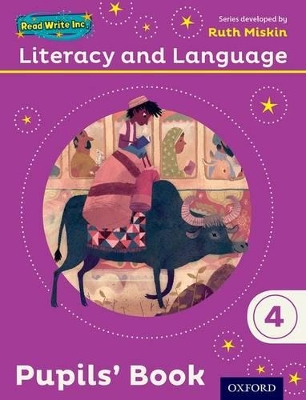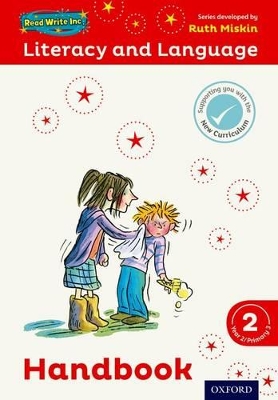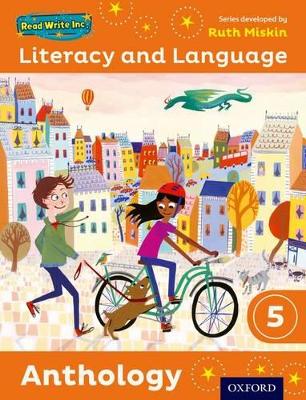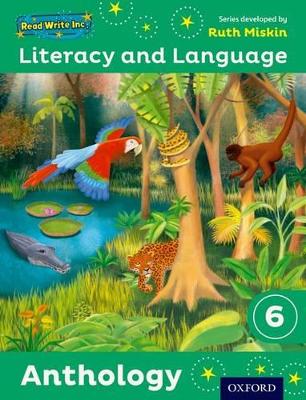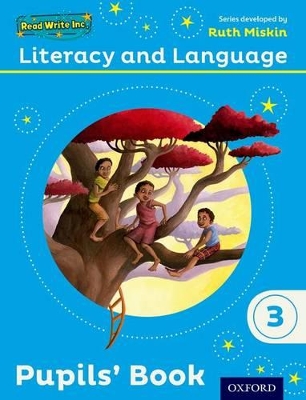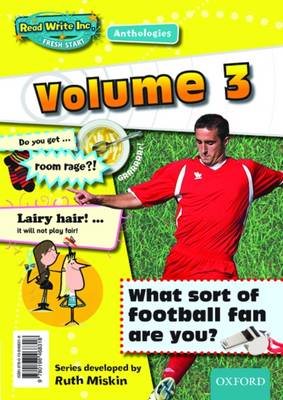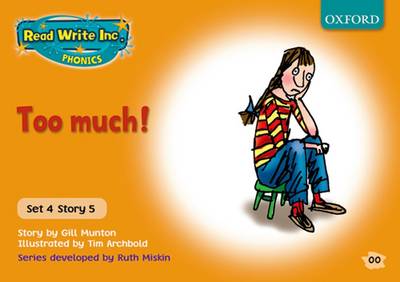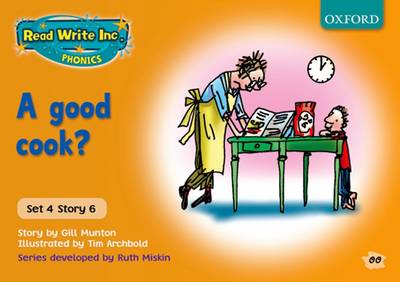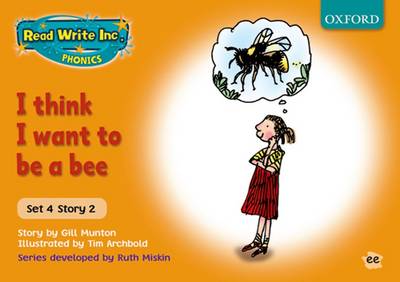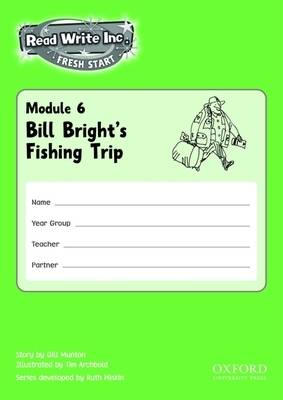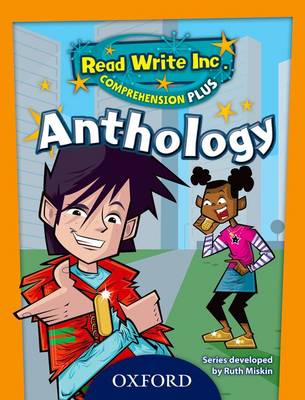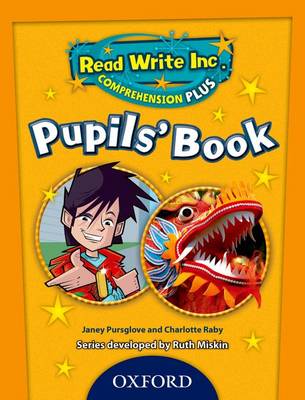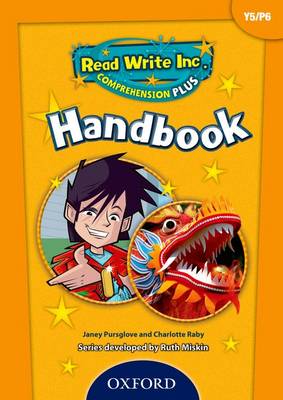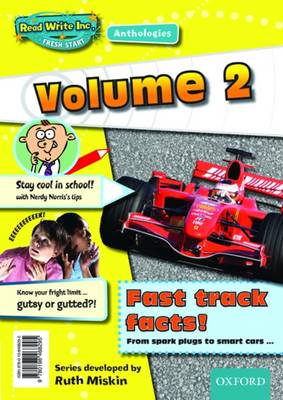Read Write Inc
140 total works
Read Write Inc.: Literacy & Language Year 4 Pupils' Book
by Ruth Miskin, Janey Pursgrove, and Charlotte Raby
The resources for each year are a Teacher's Handbook, a CD-ROM, an Anthology, a Pupils' Book and a Homework Book. Work centres around the texts in the Anthologies, which contain complete stories, poems, play scripts and non-fiction texts written by leading authors including: Michael Morpurgo, Jeremy Strong, Ted Hughes, Jamila Gavin, Geraldine McCaughrean, and Roger McGough
Children are introduced to a text through a three layered approach: Story Version 1, 2 and 3. Each version of the story contains more information about the setting, characters and plot. This approach provides children with opportunities to develop an implicit knowledge and deep understanding of the structures of language and of the stories in the Anthologies. A range of reading, writing, speaking and listening and drama activities develop understanding further.
Children then see a new text being composed through modelled writing by the teacher, through the planning, oral rehearsing, drafting and editing stages.
Supported by the teacher, the children then mirror the process the teacher has modelled, drafting and revising so that they write ambitiously and accurately as they compose their own extended piece of writing. So Literacy and Language ensures that, as the new National Curriculum advises, children learn, through being shown, the skills and processes essential for writing.
Grammar concepts are taught in context and through writing so they are meaningful for children. The Software also contains a Grammar Bank - a reference tool for teachers to help them teach grammar with confidence. It covers all the grammar concepts in the National Curriculum from Years 2-6 and includes 'Test yourself' sections, with answers, to help teachers check their understanding. There are also practice tests to prepare children for the Year 6 English Grammar, Punctuation and Spelling Test.
A 'Big Question' links the fiction and non-fiction elements, encouraging children to reason, debate and think critically about the texts they read and develop their spoken language skills.
The programme will be matched to the new curriculum and the Teacher's Handbooks show clearly how activities link to the programmes of study.
*Year 5 and 6 are new editions of a programme previously called Comprehension Plus.
Read Write Inc.: Literacy & Language: Year 6 Pupils' Book
by Ruth Miskin, Janey Pursgrove, and Charlotte Raby
The resources for each year are a Teacher's Handbook, a CD-ROM, an Anthology, a Pupils' Book and a Homework Book. Work centres around the texts in the Anthologies, which contain complete stories, poems, play scripts and non-fiction texts written by leading authors including: Michael Morpurgo, Jeremy Strong, Ted Hughes, Jamila Gavin, Geraldine McCaughrean, and Roger McGough
Children are introduced to a text through a three layered approach: Story Version 1, 2 and 3. Each version of the story contains more information about the setting, characters and plot. This approach provides children with opportunities to develop an implicit knowledge and deep understanding of the structures of language and of the stories in the Anthologies. A range of reading, writing, speaking and listening and drama activities develop understanding further.
Children then see a new text being composed through modelled writing by the teacher, through the planning, oral rehearsing, drafting and editing stages.
Supported by the teacher, the children then mirror the process the teacher has modelled, drafting and revising so that they write ambitiously and accurately as they compose their own extended piece of writing. So Literacy and Language ensures that, as the new National Curriculum advises, children learn, through being shown, the skills and processes essential for writing.
Grammar concepts are taught in context and through writing so they are meaningful for children. The Software also contains a Grammar Bank - a reference tool for teachers to help them teach grammar with confidence. It covers all the grammar concepts in the National Curriculum from Years 2-6 and includes 'Test yourself' sections, with answers, to help teachers check their understanding. There are also practice tests to prepare children for the Year 6 English Grammar, Punctuation and Spelling Test.
A 'Big Question' links the fiction and non-fiction elements, encouraging children to reason, debate and think critically about the texts they read and develop their spoken language skills.
The programme will be matched to the new curriculum and the Teacher's Handbooks show clearly how activities link to the programmes of study.
*Year 5 and 6 are new editions of a programme previously called Comprehension Plus.
Literacy & Language: Year 2 Teaching Handbook
by Ruth Miskin, Janey Pursgrove, and Charlotte Raby
and build your knowledge. It engages children and builds their vocabulary using drama and discussion activities.
Read Write Inc.: Literacy & Language: Year 5 Anthology
by Ruth Miskin, Janey Pursgrove, and Charlotte Raby
Read Write Inc.: Literacy & Language: Year 6 Anthology
by Ruth Miskin, Janey Pursgrove, and Charlotte Raby
The resources for each year are a Teacher's Handbook, a CD-ROM, an Anthology, a Pupils' Book and a Homework Book. Work centres around the texts in the Anthologies, which contain complete stories, poems, play scripts and non-fiction texts written by leading authors including: Michael Morpurgo, Jeremy Strong, Ted Hughes, Jamila Gavin, Geraldine McCaughrean, and Roger McGough
Children are introduced to a text through a three layered approach: Story Version 1, 2 and 3. Each version of the story contains more information about the setting, characters and plot. This approach provides children with opportunities to develop an implicit knowledge and deep understanding of the structures of language and of the stories in the Anthologies. A range of reading, writing, speaking and listening and drama activities develop understanding further.
Children then see a new text being composed through modelled writing by the teacher, through the planning, oral rehearsing, drafting and editing stages.
Supported by the teacher, the children then mirror the process the teacher has modelled, drafting and revising so that they write ambitiously and accurately as they compose their own extended piece of writing. So Literacy and Language ensures that, as the new National Curriculum advises, children learn, through being shown, the skills and processes essential for writing.
Grammar concepts are taught in context and through writing so they are meaningful for children. The Software also contains a Grammar Bank - a reference tool for teachers to help them teach grammar with confidence. It covers all the grammar concepts in the National Curriculum from Years 2-6 and includes 'Test yourself' sections, with answers, to help teachers check their understanding. There are also practice tests to prepare children for the Year 6 English Grammar, Punctuation and Spelling Test.
A 'Big Question' links the fiction and non-fiction elements, encouraging children to reason, debate and think critically about the texts they read and develop their spoken language skills.
The programme will be matched to the new curriculum and the Teacher's Handbooks show clearly how activities link to the programmes of study.
*Year 5 and 6 are new editions of a programme previously called Comprehension Plus.
Read Write Inc.: Literacy & Language: Year 3 Pupils' Book
by Ruth Miskin, Janey Pursgrove, and Charlotte Raby
The resources for each year are a Teacher's Handbook, a CD-ROM, an Anthology, a Pupils' Book and a Homework Book. Work centres around the texts in the Anthologies, which contain complete stories, poems, play scripts and non-fiction texts written by leading authors including: Michael Morpurgo, Jeremy Strong, Ted Hughes, Jamila Gavin, Geraldine McCaughrean, and Roger McGough
Children are introduced to a text through a three layered approach: Story Version 1, 2 and 3. Each version of the story contains more information about the setting, characters and plot. This approach provides children with opportunities to develop an implicit knowledge and deep understanding of the structures of language and of the stories in the Anthologies. A range of reading, writing, speaking and listening and drama activities develop understanding further.
Children then see a new text being composed through modelled writing by the teacher, through the planning, oral rehearsing, drafting and editing stages.
Supported by the teacher, the children then mirror the process the teacher has modelled, drafting and revising so that they write ambitiously and accurately as they compose their own extended piece of writing. So Literacy and Language ensures that, as the new National Curriculum advises, children learn, through being shown, the skills and processes essential for writing.
Grammar concepts are taught in context and through writing so they are meaningful for children. The Software also contains a Grammar Bank - a reference tool for teachers to help them teach grammar with confidence. It covers all the grammar concepts in the National Curriculum from Years 2-6 and includes 'Test yourself' sections, with answers, to help teachers check their understanding. There are also practice tests to prepare children for the Year 6 English Grammar, Punctuation and Spelling Test.
A 'Big Question' links the fiction and non-fiction elements, encouraging children to reason, debate and think critically about the texts they read and develop their spoken language skills.
The programme will be matched to the new curriculum and the Teacher's Handbooks show clearly how activities link to the programmes of study.
*Year 5 and 6 are new editions of a programme previously called Comprehension Plus.
Read Write Inc Phonics: Storybook and Non-fiction Super Easy Buy Pack
by Gill Munton
phonic knowledge so they can read them with accuracy, fluency and comprehension. The Storybooks include engaging stories such as fairy tales, myths and legends, rhyming stories and familiar
settings. Activities at the start help children to practise the sounds and words they will encounter in the story. Questions to talk about at the end provide an extra opportunity for developing childrens comprehension.The Non-fiction books cover topics including space, cooking and camping. The clear design helps children learn how to read non-fiction features including captions, labels and diagrams.This pack is part of the wider Read Write Inc. Phonics programme,
developed by Ruth Miskin. The programme is designed to create fluent readers, confident speakers and willing writers. It includes Handbooks, Sounds Cards, Word Cards, Storybooks, Non-fiction, Writing books and
an Online resource. Read Write Inc. is fully supported by comprehensive professional development from Ruth Miskin Training.
and Storytime and home reading advice. Sample copies of the Storybooks are included to provide an overview of the range of stories in the programme as well as demonstrate the clear progression from the
beginning to the end of the programme. Sample copies of the Non-fiction books show the variety of reading in the programme. Finally, sample copies of the Get Writing! books provide an overview of the range of composition and grammar, vocabulary and spelling activities.This pack is part of the wider Read Write Inc. Phonics programme, developed by Ruth Miskin. The programme is designed to create fluent readers, confident speakers and willing writers. It includes Handbooks, Sounds
Cards, Word Cards, Storybooks, Non-fiction, Writing books and an Online resource. Read Write Inc. is fully supported by comprehensive professional development from Ruth Miskin Training.
The Anthology texts should be read in order after each Module is completed, to ensure students are reading within their phonic knowledge and so experience success in reading. The subjects of the Anthology texts are linked to the Module texts so that some of the vocabulary students meet will be familiar and so support independent reading.
The Anthology texts should be read in order after each Module is completed, to ensure students are reading within their phonic knowledge and so experience success in reading. The subjects of the Anthology texts are linked to the Module texts so that some of the vocabulary students meet will be familiar and so support independent reading.
Read Write Inc Phonics Orange Set 4 Storybooks A Good Cook?
by Gill Munton
Read Write Inc Phonics Orange Set 4 Storybooks I Think I Want to Be a Bee
by Gill Munton
Read Write Inc Comprehension Plus Year 5 Anthology
by Janey Pursglove, Charlotte Raby, and Ruth Miskin
Speaking and listening is at the core of the programme and is integrated throughout. The programme is a perfect match to the renewed Framework. Text types have been chosen to support the PNS unit plans and writing support is also provided. The Teacher's Handbooks show clearly how Framework objectives for England and QCDA Assessment focuses are covered, and show links to the Scottish, Welsh and Northern Irish curricula. (Please note that the CD is PC only.)
Read Write Inc Non-Fiction Super School Pack Level 4-7
by Ruth Miskin and Gill Munton
Read Write Inc Comprehension Plus Year 5 Pupil Book
by Ruth Miskin, Janey Pursglove, and Charlotte Raby
Speaking and listening is at the core of the programme and is integrated throughout. The programme is a perfect match to the renewed Framework. Text types have been chosen to support the PNS unit plans and writing support is also provided. The Teacher's Handbooks show clearly how Framework objectives for England and QCDA Assessment focuses are covered, and show links to the Scottish, Welsh and Northern Irish curricula. (Please note that the CD is PC only.)
Read Write Inc Comprehension Plus Year 5 Teachers Handbook
by Ruth Miskin, Janey Pursglove, and Charlotte Raby
Speaking and listening is at the core of the programme and is integrated throughout. The programme is a perfect match to the renewed Framework. Text types have been chosen to support the PNS unit plans and writing support is also provided. The Teacher's Handbooks show clearly how Framework objectives for England and QCDA Assessment focuses are covered, and show links to the Scottish, Welsh and Northern Irish curricula. Please note that the CD is PC only.
The Anthology texts should be read in order after each Module is completed, to ensure students are reading within their phonic knowledge and so experience success in reading. The subjects of the Anthology texts are linked to the Module texts so that some of the vocabulary students meet will be familiar and so support independent reading.
The Anthology texts should be read in order after each Module is completed, to ensure students are reading within their phonic knowledge and so experience success in reading. The subjects of the Anthology texts are linked to the Module texts so that some of the vocabulary students meet will be familiar and so support independent reading.
